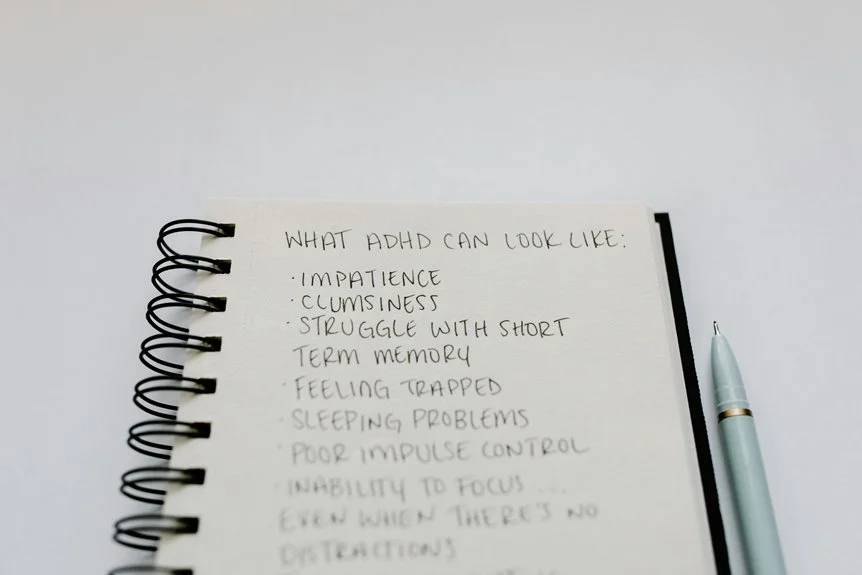
You might be surprised to discover that what looks like ADHD in yourself or your loved ones could actually be something entirely different, and I’ve learned this lesson the hard way after years of misunderstanding my own scattered focus and restless energy. In my experience, there are at least eleven common conditions that masquerade as ADHD, fooling even healthcare professionals, and recognizing these imposters could save you months of frustration and ineffective treatments that never quite hit the mark.
Key Takeaways
- Anxiety disorders create scattered attention and restlessness but include physical stomach sensations unlike ADHD’s neutral fidgeting.
- Depression drains motivation to start tasks, while ADHD individuals remain enthusiastic but struggle maintaining focus once begun.
- Chronic sleep deprivation mimics ADHD through concentration problems, memory issues, and impulsive behavior that resolve with better sleep.
- Chronic stress and burnout temporarily impair executive function, but symptoms improve when underlying stressors are addressed.
- Medical conditions like thyroid disorders, nutritional deficiencies, and certain medications can produce ADHD-like concentration and memory problems.
Anxiety Disorders
Many people don’t realize how sneaky anxiety can be when it comes to mimicking ADHD symptoms, and I’ve noticed this confusion happens more often than you’d think.
When you’re anxious, your mind races constantly, making it nearly impossible to focus on tasks that matter, which looks exactly like ADHD inattention. I’ve seen people fidget relentlessly during stressful meetings, tap their feet, or constantly shift positions—classic hyperactive behaviors that aren’t actually ADHD.
In my experience, anxiety-driven restlessness comes with that familiar knot in your stomach, while ADHD fidgeting feels more neutral. The key difference I’ve observed is that anxiety symptoms usually spike during specific triggers or situations, whereas ADHD symptoms remain consistently present across different environments and circumstances.
Understanding that your brain’s ancient wiring often treats everyday decisions and situations as potential threats can help explain why anxiety creates such scattered attention patterns that mimic ADHD symptoms.
Depression and Mood Disorders
When I first started learning about mental health conditions, I honestly didn’t expect depression to masqueraders as ADHD so convincingly, but I’ve discovered that the cognitive fog and concentration problems can be nearly identical.
I’ve noticed that when you’re dealing with with depression, your brain feels like it’s running through molasses, making it nearly impossible to focus on tasks or retain information. In my experience, the key difference lies in motivation – with ADHD, you’re usually enthusiastic to tackle projects but get derailed by distractions, while depression drains your desire to even start.
You’ll find yourself staring at your computer screen, knowing exactly what needs to be done but feeling completely disconnected from any drive to actually do it. Both conditions can also trigger intense emotions that feel overwhelming and difficult to regulate, making it even harder to distinguish between the two.
Sleep Deprivation and Sleep Disorders
Another condition that’s fooled me more times than I care to admit is chronic sleep deprivation, and I’ve learned that running on four to five hours of sleep per night creates symptoms that look remarkably similar to ADHD. When you’re consistently getting inadequate sleep, your brain’s executive functions start breaking down, and I’ve noticed this mimics ADHD’s hallmark struggles with focus and impulse control.
| Sleep-Deprived Symptoms | ADHD-Like Behaviors |
|---|---|
| Difficulty concentrating | Can’t focus on tasks |
| Memory problems | Forgetfulness, losing items |
| Emotional volatility | Mood swings, irritability |
| Poor decision-making | Impulsive choices |
| Restlessness | Hyperactive behavior |
The key to breaking this cycle lies in establishing consistent sleep patterns, as irregular sleep schedules can disrupt your circadian rhythm and worsen these ADHD-like symptoms. In my experience, tracking your sleep with apps like Sleep Cycle helps identify patterns, and addressing sleep apnea or insomnia often resolves these “ADHD” symptoms completely.
Chronic Stress and Burnout

When you’re drowning in deadlines, juggling family responsibilities, and running on empty for months at a time, I’ve noticed that chronic stress can hijack your brain in ways that look suspiciously like ADHD, making you feel scattered, forgetful, and unable to focus even on tasks you normally handle with ease.
In my experience, prolonged burnout creates this fog where your executive function basically throws in the towel, leaving you staring at your to-do list like it’s written in ancient hieroglyphics, even though last year you were the person everyone came to for organization tips.
The tricky part is that stress-induced concentration problems can mirror classic ADHD symptoms so closely that you might find yourself wondering if you’ve had undiagnosed ADHD all along, when really your brain is just desperately waving a white flag after months of operating in survival mode.
If you’re experiencing persistent symptoms of inattention, hyperactivity, and impulsivity that significantly impact your work, relationships, and daily tasks, consulting a doctor can help determine whether you’re dealing with stress-related issues or if you need a proper ADHD evaluation.
Stress Mimics ADHD Symptoms
The relentless pressure of modern life can create a perfect storm of symptoms that mirror ADHD so convincingly, you’d swear your brain has suddenly developed a case of executive function amnesia. I’ve noticed that when stress reaches toxic levels, your mind starts playing tricks that feel eerily familiar to those with ADHD.
| Stress Response | ADHD-Like Symptom | Key Difference |
|---|---|---|
| Racing thoughts | Hyperactivity/restlessness | Triggered by specific stressors |
| Mental fatigue | Inattention/focus issues | Improves with rest |
| Overwhelm paralysis | Executive dysfunction | Situational, not lifelong |
| Cortisol crashes | Emotional dysregulation | Follows stress patterns |
| Sleep disruption | Concentration problems | Resolves with better sleep |
In my experience, stress-induced symptoms improve dramatically when you address the underlying pressure, unlike genuine ADHD.
Burnout Affects Executive Function
Chronic stress that persists for months or years doesn’t just mimic ADHD symptoms—it actually rewires your brain’s executive control center in ways that can fool even experienced healthcare providers.
I’ve noticed that when you’re running on empty for extended periods, your prefrontal cortex starts functioning like a computer with too many programs open, slowing everything down to a crawl.
In my experience, burnout creates this fog where you can’t prioritize tasks, recollect important details, or maintain focus on conversations—classic ADHD red flags. Your working memory becomes unreliable, you procrastinate on simple tasks, and decision-making feels overwhelming.
The tricky part is that burnout-induced executive dysfunction can persist even after you’ve addressed the initial stressors, making the distinction particularly challenging.
Thyroid Disorders
Although your doctor mightn’t immediately think to check it, I’ve noticed that thyroid problems can create a surprisingly convincing ADHD impersonation that’ll leave you wondering why your brain feels like it’s running on dial-up internet.
When your thyroid’s underactive, you’ll experience brain fog, memory lapses, and concentration issues that mirror ADHD symptoms perfectly. I’ve seen people struggle with what they thought was attention deficit, only to discover their TSH levels were through the roof.
The tricky part is that standard thyroid panels often miss subclinical cases, so you’ll want to request thorough testing including T3, T4, reverse T3, and thyroid antibodies. In my experience, addressing thyroid dysfunction first can dramatically improve cognitive function before considering ADHD treatment.
Additionally, your gut’s enteric nervous system can influence cognitive function and mood through complex biochemical pathways, potentially contributing to ADHD-like symptoms when disrupted.
Iron Deficiency and Nutritional Deficiencies
You might be surprised to learn that something as simple as low iron can make your brain feel like it’s running on dial-up internet, and I’ve noticed that many people overlook how nutritional deficiencies can perfectly mimic ADHD symptoms in ways that’ll have you convinced you need medication when you might just need a better breakfast.
In my experience, iron deficiency hits your focus and energy like a one-two punch, while missing out on key B-vitamins can leave your brain feeling scattered and forgetful, much like when I realized my “ADHD brain fog” was actually just months of skipping meals and living on coffee.
What’s particularly sneaky is how magnesium deficiency can make you feel restless and unable to concentrate, creating that familiar can’t-sit-still sensation that looks exactly like hyperactivity but responds beautifully to some simple dietary tweaks.
The interesting thing is that these nutritional deficiencies can affect the same brain regions involved in ADHD, including the prefrontal cortex, which explains why the symptoms can be so convincingly similar.
Iron’s Brain Function Impact
Many people don’t realize that iron deficiency can masquerade as ADHD so convincingly that I’ve seen countless parents and adults chase the wrong diagnosis for months. Your dopamine production takes a nosedive, which directly impacts your ability to focus and control impulses.
Iron literally helps transport oxygen to your brain cells, and without enough of it, you’re fundamentally running on mental fumes. In my experience, the symptoms mirror ADHD perfectly – you’ll struggle with concentration, feel restless, and have trouble completing tasks.
I’ve watched clients improve dramatically after addressing iron deficiency through supplements like Slow Fe or iron-rich foods, often seeing focus improvements within weeks.
B-Vitamin Deficiency Symptoms
While iron deficiency gets most of the attention, B-vitamin deficiencies can create an equally convincing ADHD impersonation that I’ve seen trip up even experienced healthcare providers. In my experience, B12, B6, and folate deficiencies particularly excel at mimicking attention disorders, causing brain fog that’ll make you question your entire cognitive function.
| B-Vitamin | Primary ADHD-Like Symptoms |
|---|---|
| B12 | Memory lapses, concentration problems |
| B6 | Irritability, mental fatigue |
| Folate | Focus issues, mood swings |
| Thiamine (B1) | Mental confusion, attention deficits |
I’ve noticed these deficiencies often develop gradually, making them sneaky culprits. You might blame stress or aging when it’s actually your methylated B-complex running on empty. Simple blood tests can reveal the truth, giving you the power to address the real issue instead of chasing ADHD symptoms.
Magnesium and Focus Connection
Although magnesium doesn’t get nearly the spotlight it deserves, this mineral powerhouse has become my go-to suspect when clients complain about scattered focus and restless energy that screams ADHD. I’ve noticed that when you’re magnesium-deficient, your brain literally can’t calm down enough to concentrate, and honestly, I learned this the hard way after months of thinking I needed stronger coffee when I really needed better minerals.
In my experience, magnesium glycinate works best for focus issues since it crosses the blood-brain barrier more effectively than cheaper forms like magnesium oxide. You’ll want to start with 200-400mg before bed, and I’ve watched countless clients report clearer thinking within two weeks, which beats jumping straight to ADHD medications.
Medication Side Effects
If you’re taking prescription medications, there’s a decent chance they could be mimicking ADHD symptoms without you even realizing it, and I’ve learned this lesson the hard way after spending months wondering why my focus seemed to get worse instead of better. In my experience, certain medications create brain fog that feels identical to ADHD’s concentration struggles.
| Medication Type | ADHD-Like Side Effects |
|---|---|
| Antihistamines (Benadryl, Claritin) | Mental cloudiness, inability to concentrate |
| Blood Pressure Meds (Metoprolol) | Memory problems, scattered thinking |
| Antidepressants (Zoloft, Lexapro) | Restlessness, racing thoughts |
| Sleep Aids (Ambien, melatonin) | Next-day brain fog, attention issues |
| Pain Medications (opioids) | Cognitive dulling, focus problems |
I’ve noticed reviewing your medication list with your doctor can reveal surprising culprits behind your concentration struggles. Understanding these root causes helps you make better choices about managing your symptoms and finding the right treatment approach.
Autism Spectrum Disorder
You might notice that what seems like ADHD distractibility could actually be your brain processing sensory information differently, like when I’ve watched kids cover their ears in noisy classrooms not because they can’t focus, but because the fluorescent lights are humming too loudly for their sensory system to handle.
In my experience, social communication challenges can also masquerade as ADHD inattention, especially when you’re working so hard to decode facial expressions, tone of voice, and unspoken social rules that you miss half of what’s being said in conversations or meetings.
I’ve noticed that repetitive behaviors like fidgeting, organizing, or even repeating certain phrases can look exactly like ADHD hyperactivity or impulsiveness, but they’re actually your way of self-regulating and creating predictability in an overwhelming world.
This overlap can be particularly confusing for women, since ADHD can present differently in women compared to men, making it even more challenging to distinguish between autism spectrum traits and ADHD symptoms.
Sensory Processing Differences
When I first started working with kids who seemed to have ADHD symptoms, I kept noticing something puzzling—some children would appear completely inattentive during certain activities, yet they’d become laser-focused when the environment changed slightly, like dimming the overhead lights or moving to a quieter corner of the room.
I’ve learned that sensory processing differences often masquerade as ADHD symptoms, and honestly, I missed this connection for way too long. In my experience, you’ll spot these patterns when you start tracking environmental factors alongside behavior.
- Monitor lighting sensitivity – fluorescent bulbs can trigger apparent inattention
- Track noise levels – background sounds might overwhelm their processing capacity
- Observe texture reactions – clothing tags or chair materials can cause fidgeting
Understanding these sensory triggers gives you tremendous power to create conducive learning environments.
Social Communication Challenges
Three years into my career, I encountered a bright seven-year-old who couldn’t sit still during group discussions, seemed to ignore direct instructions, and appeared completely disengaged during social activities—classic ADHD red flags, right? Wrong.
After careful observation, I’ve noticed this child was actually struggling with autism spectrum disorder, specifically social communication challenges that masqueraded as attention deficits. In my experience, kids with ASD often fidget during social interactions because they’re overwhelmed by the unspoken rules of conversation, not because they can’t focus. They may ignore instructions because they’re processing the literal meaning rather than the social context, and they withdraw from group activities because managing peer dynamics feels impossibly complex, leaving you thinking it’s hyperactivity when it’s actually social confusion.
Repetitive Behavior Patterns
Another red flag I’ve learned to watch for involves repetitive behaviors that can easily fool you into thinking a child has ADHD hyperactivity when they’re actually displaying autism spectrum patterns. I’ve noticed these behaviors masquerade as restlessness, but they’re actually self-regulation mechanisms that serve completely different purposes than the fidgeting you’d see with ADHD.
In my experience, here’s what to watch for:
- Hand flapping or rocking – These aren’t random movements but purposeful stimming behaviors that help with sensory processing
- Repeated phrases or echolalia – The child keeps saying the same things, which looks like impulsivity but is actually communication processing
- Rigid routines – What appears as oppositional behavior is actually distress when predictable patterns get disrupted
Learning Disabilities
Although learning disabilities often fly under the radar, I’ve noticed they’re frequently mistaken for ADHD because both conditions can make focusing and completing tasks feel like trying to solve a puzzle with half the pieces missing.
In my experience, when you’re struggling with dyslexia, dyscalculia, or processing disorders, your brain works overtime just to decode information, leaving little energy for sustained attention. I’ve seen students who appear hyperactive or distracted during reading time, but they’re actually compensating for visual processing issues, not dealing with ADHD.
The key difference I’ve observed is that learning disabilities create specific skill gaps, while ADHD affects executive function across multiple areas, so you’ll want extensive testing to distinguish between these conditions. Just like how hair growth requires addressing underlying causes rather than just treating surface symptoms, properly identifying learning disabilities means looking beyond the visible behaviors to understand the root processing challenges.
Bipolar Disorder
When I first learned about bipolar disorder, I was struck by how easily its manic episodes can masquerade as ADHD hyperactivity, especially since both conditions involve periods of restlessness, rapid speech, and impulsive decision-making that can leave you feeling like your brain’s running at double speed.
I’ve noticed the key differences that give you diagnostic power:
- Mood cycling patterns – Bipolar disorder creates distinct episodes lasting days or weeks, while ADHD symptoms remain consistent daily, and I’ve seen people misinterpret their manic phases as sudden ADHD breakthroughs.
- Sleep disruption severity – During manic episodes, you might function on two hours of sleep feeling energized, whereas ADHD-related sleep issues don’t eliminate your need for rest.
- Grandiose thinking emergence – Mania often brings unrealistic self-confidence that’s absent in typical ADHD presentations.
The impulsive nature of manic episodes can severely compromise strategic decision-making, leading to choices that create long-term consequences rather than the more manageable day-to-day impulsivity seen in ADHD.
Digital Overload and Technology Addiction
Since we’re practically swimming in screens these days, I’ve discovered that what many people mistake for ADHD might actually be their brain’s overwhelmed response to constant digital stimulation, and honestly, I didn’t realize how much my own focus issues stemmed from bouncing between Instagram notifications, Slack messages, and YouTube autoplay until I started tracking my actual screen time.
I’ve noticed that when you’re switching between apps every few minutes, your brain develops this frantic, scattered feeling that mimics ADHD’s restlessness perfectly. In my experience, turning off notifications for everything except actual emergencies and using apps like Freedom to block distracting websites for specific work blocks creates dramatic improvements in concentration within just a few days.
Conclusion
If you’re struggling with ADHD-like symptoms, I’ve learned that digging deeper into what’s really going on can save you months of frustration and wrong treatments. In my experience, addressing sleep issues, managing screen time, or getting blood work done often reveals the actual culprit behind your scattered focus. Don’t assume it’s ADHD right away—you’ll thank yourself later for being thorough with your detective work first.





Leave a Reply